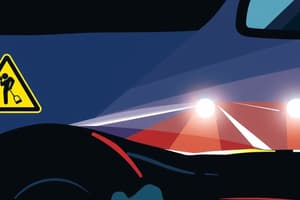Podcast
Questions and Answers
When making a long trip, how often should you stop for a rest?
When making a long trip, how often should you stop for a rest?
- Every three hours
- Every hour
- Every two hours or one hundred miles (correct)
- Every five hundred miles
How can you see better when driving in fog?
How can you see better when driving in fog?
Using lower headlight beam
When must the headlights be turned on?
When must the headlights be turned on?
30 minutes before sunset
At what distance must the lights on your vehicle be turned on when visibility is poor?
At what distance must the lights on your vehicle be turned on when visibility is poor?
What should a defensive driver do to avoid accidents?
What should a defensive driver do to avoid accidents?
Why should you drive slower at night?
Why should you drive slower at night?
What is the best action if you get drowsy while driving?
What is the best action if you get drowsy while driving?
When should a driver dim his headlights at night?
When should a driver dim his headlights at night?
Where should slow drivers drive on multiple lane highways?
Where should slow drivers drive on multiple lane highways?
What should you do if blinded by an approaching motor vehicle at night?
What should you do if blinded by an approaching motor vehicle at night?
Flashcards are hidden until you start studying
Study Notes
Long Trips and Rest Stops
- Rest every two hours or every 100 miles during long trips to maintain alertness.
Driving in Fog
- Use the lower headlight beam to enhance visibility when driving in foggy conditions.
Headlight Usage
- Headlights should be turned on 30 minutes prior to sunset for safe driving conditions.
Visibility Requirements
- Vehicle lights must be activated when visibility is reduced to less than 1000 feet, whether day or night.
Defensive Driving
- Stay vigilant by looking for potential trouble spots to avoid accidents.
Nighttime Driving Speed
- Night driving requires slower speeds due to limited visibility; the distance one can see is significantly reduced.
Addressing Drowsiness
- If feeling drowsy while driving, it is advisable to stop, exit the vehicle, and walk around to refresh.
Headlight Dimming
- Dim headlights for oncoming vehicles when they are within 500 feet to prevent glare.
Lane Usage on Highways
- Slow drivers should remain in the right-hand lane to keep traffic flowing smoothly.
Responding to Blinding Lights
- If blinded by headlights at night, slow down and avoid looking directly at the approaching lights for safety.
Studying That Suits You
Use AI to generate personalized quizzes and flashcards to suit your learning preferences.




